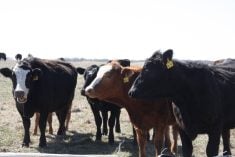This cattle market information is selected from the weekly report from Canfax, a division of the Canadian Cattlemen’s Association. More market information, analysis and statistics are available by becoming a Canfax subscriber by calling 403-275-5110 or at www.canfax.ca.
Fed cattle rise
The weighted average live fed steer price was $169.15 per hundredweight, up from the previous week and perhaps signalling that the seasonal low is behind us.
Fed supply should tighten into year’s end.
Read Also

Trump’s tariffs take their toll on U.S. producers
U.S. farmers say Trump’s tariffs have been devastating for growers in that country.
Fed prices will likely return to the low to mid $170s before the month is through.
Alberta dressed steers were in a wide range, from $262 to $288.50, with one major Alberta packer more aggressive than the other.
U.S. bids were too low to send any cattle south.
The U.S. cash market did not develop until late in the week, and when it did prices were much higher with dressed bids in Nebraska at US$205, up $10 from the previous week.
U.S. beef cutouts were also significantly stronger, even though carcass weights have not declined much yet.
December is traditionally a strong month for cattle prices, but they will likely not match the records posted earlier this year.
Canadian packers are buying out until mid-November, causing some producers to decide to accept relatively strong contract prices for December, even though they are lower than break-evens.
Alberta cash fed prices have been trading at par to a slight premium over the Nebraska market.
The weekly fed export volume of 4,510 head was the second highest since the beginning of May.
Cows down
Increasing cow supply at auction pressured prices lower.
D1, D2 cows ranged C$107-$125 to average $116.50, down $3.50, and D3 cows ranged $90-$110 to average $100.10, down $5.50.
Rail grade prices ranged $218-$223 per cwt. delivered.
Slaughter bulls fell $6 lower to average $137.14.
Weekly western Canadian slaughter to Oct. 10 fell three percent to 4,357 head.
Weekly exports to Oct. 3 dipped to 6,256 head.
Feeders firm
Alberta stocker and feeder steer prices rebounded, while heifer prices were barely steady.
Stockers 300-400 pounds rose $2.50-$3.50.
Steers 400-700 lb. rose $2.50-$4, while similar weight heifers dipped $1-$2.75.
Good demand was observed for all 700-800 lb. feeders.
Feeders heavier than 800 lb. were mixed with steers rising and heifers lower.
Calves lighter than 600 lb. were about $10 per cwt. lower than the same week last year, but those heavier than 700 lb. were $3-$5 higher.
Sales totalled 39,717 head, which was up a little from the previous week but 12 percent smaller than last year.
Weekly exports to Oct. 3 fell 40 percent to 2,490 head.
Tightening fed supply should support calf prices, but any rally will be moderated by negative feeding margins and reduced U.S. buyer interest.
U.S. beef rebounds
U.S. cutouts to Oct. 15 rose with Choice at US$211.22, up $7.61, and Select $207.23 up $9.77
Canadian beef cutouts to Oct. 9 saw AAA down C$6.23 at $271.35 and AA down $2.44 at $264.27.
Montreal wholesale prices moved lower to $312-$315 per cwt.














